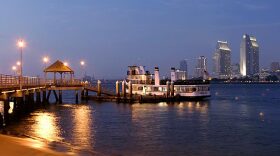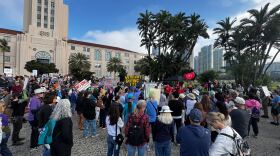Christina Barba is on a mission to set more forest fires. The good kind. The intentional kind. The kind that prevents the next wildfire from becoming a mega-fire.
On a dry afternoon last spring, she drove through stands of towering ponderosa and Jeffrey pines in San Bernardino County, just outside the mountain town of Big Bear Lake. Parking her U.S. Forest Service pickup at the top of a ridge, she pointed across a wide valley at a hillside thriving with shrubs and dotted with burnt tree trunks.
In 2007, the Butler 2 and Slide fires torched the hillside and more than 300 homes and businesses between here and Lake Arrowhead. Barba said the hillside has undergone what's known as "site conversion": New foliage has grown back, but a future for pine trees is less certain.
"In my mind," said Barba, "it's probably never going to be a forest again."
No more forest means no more habitat for local spotted owls, a lot less of the shade that makes the area a cool respite, and fewer trees to suck carbon from the warming air.
To Barba, the hillside is a reminder of what could happen if she doesn't do her job as district fuels planner with the San Bernardino National Forest, a position colloquially known as "burn boss." Since stepping into the role in 2019, she has overseen all prescribed burns on Forest Service land around Big Bear Valley, which includes the town and nearby unincorporated areas, collectively referred to as Big Bear.
Prescribed burns are widely considered a crucial form of wildfire mitigation; once an area has burned, it won't burn as hot during the next fire, which in turn decreases spread and damage until it regenerates many years in the future.

In the last century, at least 30 wildfires have come within five miles of Big Bear Lake, according to Forest Service data. While the populated areas have dodged catastrophic wildfires, that kind of luck is unlikely to hold forever. The agency has identified Big Bear Lake as being at high risk of burning in a wildfire since at least 2001. Cal Fire, the state's forest and fire agency, gives the vast majority of Big Bear Valley its highest designation for fire hazard severity.
As California faces its third year of historic drought and comes out of its two worst fire years on record, the stakes have never been higher for Big Bear, where 25,000 residents live year-round and as many as 150,000 people visit on busy holiday weekends.
"We only have three routes in and out," said Big Bear Lake Mayor Rick Herrick. "And it seems like every time we have a big fire, at least one of the routes goes down."
In the event of a massive wildfire on a crowded summer weekend, he asked rhetorically, "What do we do with everybody who's here? How do we get them off the mountain safely?"
The scenario that keeps Herrick up at night isn't far-fetched. In fact, it's why the Forest Service says it has approved nearly 9,000 acres of forest thinning and prescribed burns in the San Bernardino National Forest's Mountaintop Ranger District, where Barba works. But progress has been painfully slow.
"We should be burning 3,000 acres a year," said Barba. "And last year, we did 300."
This year has been worse. Strapped for resources and restricted by the nationwide pause on prescribed burns, Barba's district has burned a mere 20 acres. There's little chance the agency will get any more done before next year.

Knowing what she's up against has made her somewhat cynical. Even though the dead trees on the faraway hillside are less likely to fuel a mega-fire, site conversion isn't exactly cause for celebration. Her optimism was limited to a low-volume, sardonic, "Yay."
Later, by phone, she spoke more bluntly about the future of Big Bear Valley. "I believe that without any management, we're going to lose the majority of the rest of the forest," she said.
The shrinking window
After a century of fire suppression, most national forests in California are primed to burn. Climate change has brought the stark reality of warmer temperatures and drier weather. That means more fires burning hotter and for longer than in the past.
That's why national forests have long lists of fire-prevention projects to tackle, including tree thinning, flammable brush reduction, and prescribed burns.

The list of obstacles standing in the way of forest officials is just as long.
Residents of the Northern California town of Grizzly Flats know this firsthand. An investigation by KCRW's partners at CapRadio and The California Newsroom found that a stalled Forest Service project could have helped protect the foothills community from the 2021 Caldor Fire — if it weren't for all the hurdles and red tape.
Barba knows these challenges well. "I counted about 13 total days that we would have been able to burn (last) year," she said.
The main reason for the short burn window in 2021 was weather. If the forest is too wet, it won't catch fire. If it's too dry or the wind is too strong, a prescribed burn could get out of control. That's what happened here in Big Bear in 2005, when a prescribed fire escaped and burned down a building at the local ski resort. The burn scar on the ski hill is still visible to wary residents living below; even though runaway prescribed fires are rare, the optics are never good.
"After that happened, there was a lot of distrust from the community," said Barba. "There were people picketing outside of the ranger station, calling for resignations, throwing rocks."
Next on the list of obstacles in Barba's way is air quality. In the eyes of the California Air Resources Board (CARB), Big Bear and the nearby Inland Empire are part of the greater Los Angeles area. When smoggy skies in places like Fontana or Pasadena don't meet the national clean air standard, local air quality officials can say no to Barba's plans up until noon the day before a prescribed burn. In Big Bear, where the skies are usually clear, it's difficult to tell when that will happen.
"We share an air basin with Los Angeles and the entire Inland Empire. So, because the Inland Empire has ozone or some days they have more (pollution) than they should, it shuts down burning in the entire basin,” she said. “We lost about five burn days that way."
The Air Quality Management District, which is the local branch of CARB making game-day decisions about prescribed burns, says it denied only one requested burn day in Barba's district in 2021. Barba says the other four she's counting were what AQMD calls "no burn days," when prescribed burns are allowed only by exception. She says on those days, it wasn't worth the ask.
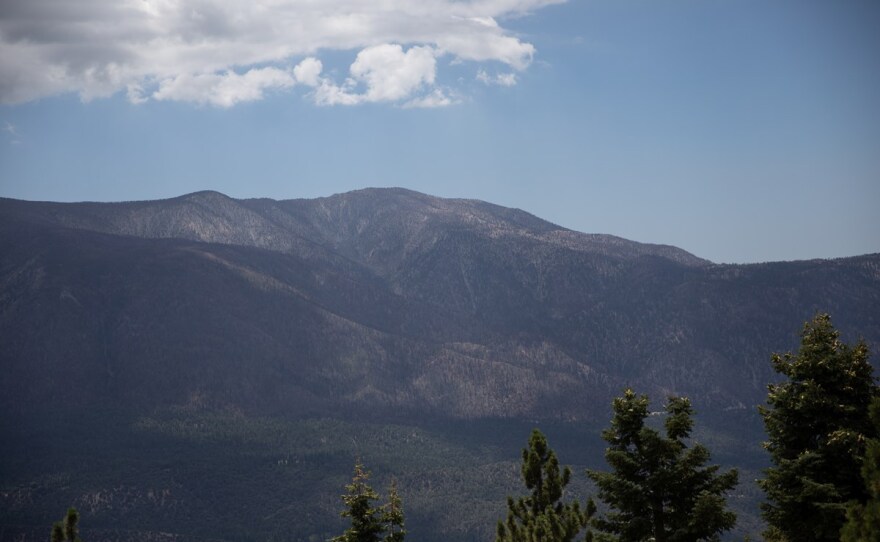
With just eight of her original 13 burn days remaining, the best she could hope for was about a quarter of her 3,000-acre goal.
Then came staffing shortages caused by an unyielding fire season.
"There's been times where I've woken up in the morning, I get a call from the fire management official: 'Three of your engines got sent on a strike team to the Cleveland (National Forest) for a fire.' And then that is the end of that," she said.
In 2021, Barba lost three of her remaining eight burn days due to staffing, shrinking her window to five days.
"With our lack of resources, while today would have been a good burn day, tomorrow we're looking at relative humidities in single digits," she explained. If a wildfire ignited, she said, "the resources would get taken away, and now we'd have a prescribed burn that we can't really mop up."
U.S. Forest Service Chief Randy Moore said he understands the frustration of burn bosses like Barba.
"I mean, they're right. Budget and keeping boots on the ground has been a big issue," he said in a recent interview. "We don't have a lot of prescribed burning there, particularly down in Southern California. We never have. And that's been the problem: We have not been able to treat at scale."
Time is money
Even on a perfect day, when the weather is right and the air is clear and firefighters have nothing better to do, prescribed fires still burn up money the San Bernardino National Forest can't spare.
It doesn't help that Big Bear is an expensive place to set controlled burns. "In Southern California, or any area where you've got a community involved, the prescribed burning costs more," Moore said.
That's because burning near homes leaves a very small margin for error, so the Forest Service has to pay for more personnel to make sure nearby residents stay safe.
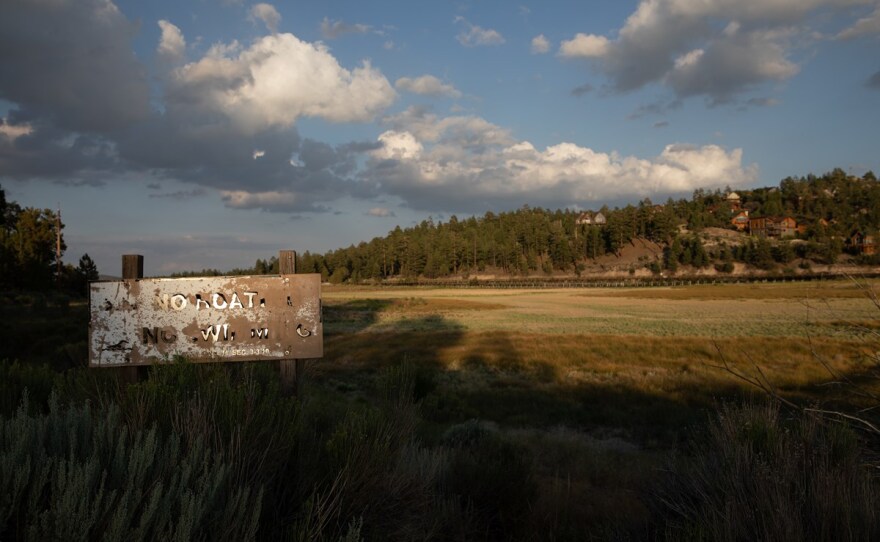
Barba estimates that prescribed burns cost roughly $200 per acre. She hopes to tackle more than 20,000 acres, but most of that is currently in the planning stage. Pulling it all off would require more than $4 million that simply isn't available.
The Forest Service did not provide KCRW and The California Newsroom with budget information for the San Bernardino National Forest, despite multiple requests.
Barba said she couldn't disclose her budget this year either, but she gave a hint: "Take away a zero and you're probably closer," she said. "I think my house is worth more than the budget this year."
That doesn't surprise David Kelley, who in 2017 retired from his job as the division chief of the Mountaintop Ranger District. "There's still plans out there to be done on the whole Santa Ana River drainage," he said, referring to the district's Santa Ana Watershed Hazardous Fuels Reduction and Forest Health project, which has been in limbo since 2012. "It stalled due to lack of funds, lack of people on the Forest Service side because of downsizing, and then lack of money to get it done. And that's just the way it goes."
It's not the only project that fell through during his tenure. The Forest Service is trying to get another 13,000-acre project north of Big Bear Lake approved — after an earlier project in the same location petered out.
Kelley said the cycle of starting, stopping, but not finishing work is familiar from his time with the Forest Service.
"The way the Forest Service has habitually worked is we'd do a bunch of work and then we pat ourselves on the back and then we don't do anything until it's too late and we have to do it all over again," he said.
Since 2007, the agency has completed 8,000 acres of hazardous fuels reduction treatments around Big Bear, according to its own data. In the meantime, work within nearly 24,000 acres has been put on hold, left unfinished or canceled.
To thin or not to thin
Besides weather, air quality, staffing issues and budget issues, there's another hurdle for burn bosses throughout the West: opposition from environmental groups.
In Big Bear, the Sierra Club wants to protect a pair of beloved bald eagles that nest by the lake each year.
The John Muir Project, meanwhile, has concerns about the Forest Service's broader strategies in the area, in particular a process known as "commercial thinning," in which some trees are cut in order to reduce fuel loads, and then sold to offset costs. The Forest Service says that some commercial thinning is required to carry out prescribed burns on its 13,000-acre North Big Bear project. Fire ecologist and John Muir Project co-founder Chad Hanson, who lives in Big Bear Valley, opposes the agency's plans for commercial thinning.
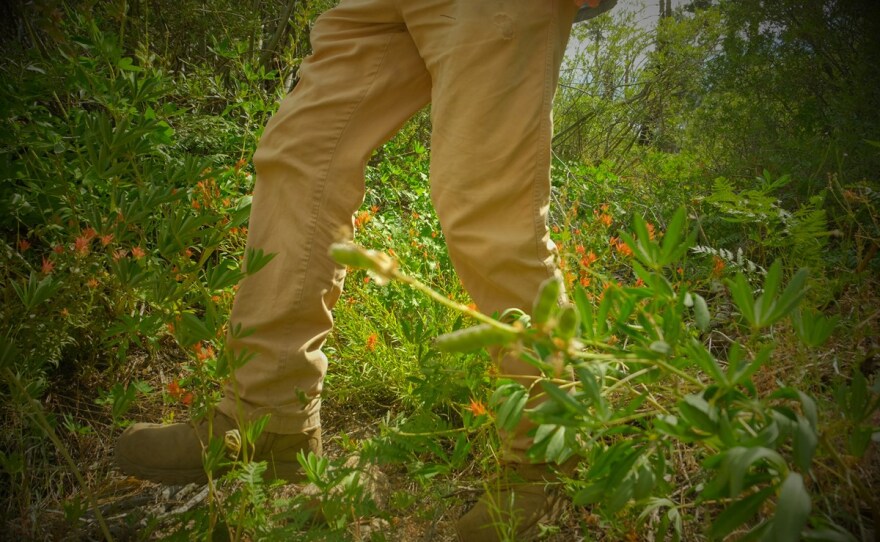
His primary concern is that commercial thinning will include removal of too many mature trees, rather than just smaller ones; doing so will "increase, not decrease, fire severity" in the area, according to a written objection his organization filed with the Forest Service this month.
In interviews, Hanson questioned the motives behind the project.
"(It's) a logging project under the deceptive guise of commercial thinning," he said. "It's bulldozers, chain saws and fields of big stumps."
Hanson favors limited, noncommercial thinning of small trees located close to homes as a way to create buffer zones commonly known as "defensible space."
"We'd strongly consider litigation if the Forest Service is not willing to make substantial changes to its plans," he said.
Hanson said he also wants the Forest Service to put more resources toward helping communities "harden" their homes with things like nonflammable building materials and ember-proof vents.
For Barba, the burn boss, objection from environmental groups is just one more item on a list that stands in the way of her job. She joked about a common refrain in her line of work.
"You could always find a reason not to burn," she said. She paused for a moment. "Sorry, there's my cynicism again."
Fingers crossed
In April, Mayor Herrick sat at a picnic table by Big Bear Lake, where water levels are so low that people walk several hundred feet past beached boats and docks to dip their toes in the water. Most residents have recognized the risk of climate change and are coming around to the idea of forest thinning and prescribed burns, he said. They're wiser and more prepared for wildfire than they used to be.

"Thirty-plus years ago, we loved our forest, but we almost loved it to death because we wouldn't touch it," he said. "Boy, it seems like (treating) it just takes an awful long time."
While they wait, some people in Big Bear have taken matters into their own hands. After the 2018 Camp Fire killed dozens and burned down the town of Paradise, Big Bear residents formed a volunteer fire safe council under the leadership of Patrice Duncan, who's also the president of a local property owners association.
"As a resident, I can keep my pine needles picked up and I can make sure my home is safe," said Duncan. "But if the forest is coming at me because it wasn't managed well, there's not a whole lot I'm going to be able to do about it."
Duncan said she hopes the council helps residents put pressure on the Forest Service to keep their projects alive.
"People take for granted that the government's going to take care of them when there's a major disaster," she said. "And I don't think people understand how much residents need to own what's happening. Our fire services up here are spread so thin."
They might be even thinner this year as a warmer, drier climate and an unrelenting drought put 2022 on track to be another record-breaking fire year in Southern California.
Typically the worst fires happen in the fall, so Big Bear's most vulnerable days are still ahead. Given how little work the Forest Service is able to accomplish, Mayor Herrick is counting on effective responses from residents and firefighters — and a bit of good fortune.
"We're going to have to be very vigilant," he said. "We've been very lucky. Let's keep our fingers crossed and make sure that we stay lucky."



